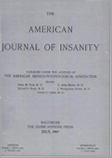Abstract
The central point of this study has been the miliary plaques commonly found in the brains of persons dying at an advanced age. Consideration, however, has been given many other factors which might have a causative relationship, or at least serve as an explanation for these peculiar structures. A reasonable number of cases, 89, have been studied more or less systematically and 4 other cases added to the supplementary group discussed under Section VIII brings the total to 93. Some of the findings lead to conclusions which may be stated with a degree of positiveness almost axiomatic; others still await interpretation. The results of this study may be summarized as follows:
(1) While 87.5 per cent of plaque cases exhibited atrophy sufficiently marked to be detected with the unaided eye, other cases with equally marked atrophy were without plaques. Cases with brains weighing well within the range of accepted normal weight have shown plaques on microscopical examination, while other cases coming under the same category have been negative.
(2) A large percentage, 62, of plaque brains exhibited gross focal lesions resulting from arteriosclerosis and all showed more or less advanced cerebral arteriosclerosis. But cerebral arteriosclerosis was even more pronounced in non-plaque brains. Arteriosclerosis per se, therefore, appears to have little, if any, direct causative relationship to the formation of plaques.
(3) Brains exhibiting general histological evidence of senile involution, whether from persons dying insane, or from persons dying without psychosis, are the most likely to yield plaques.
(4) Since plaques have been found in the brains of elderly persons dying insane and in the brains of elderly persons dying without psychosis, and also as recorded in the cases of a young tabetic without psychosis, these peculiar structures cannot be considered as characteristic for any special form of mental disease, although occurring with greater frequency in senile dementia than in any other form of insanity.
(5) The onset of senile involution varies in different persons and this may explain the presence of plaques in the brains of some elderly persons and their absence in others.
(6) From the evidence furnished by Case XV of this series and the published cases of Alzheimer and Perusini, a precocious senium is conceivable. By precocious senium something more than an early cerebral arteriosclerosis is meant.
(7) Plaques when present in a given subject are more numerous in the portions of the brain which show the maximum of general pathological alterations. Hence in senile dementia the group of cases which shows the most frequent and extensive involvement, the frontal and hippocampal regions, as a rule, exhibit the greatest number of plaques.
(8) The presence of plaques in the molecular layer of the cortex and in the white substance, often in great numbers, leads the writer to contend against an origin from degenerating ganglion cells. The view of deposited products of pathological metabolism resulting from degenerating nervous elements (fibrils) is advocated. The glial and also the apparently incontrovertible neural proliferations are interpreted as attempts at elimination of the deposited products. These attempts at elimination and replacement, nevertheless, do not appear successful.
(9) The general histological evidence of these cases tends to show a similarity between the lesions of senile dementia and normal senile involution of the brain. The non-plaque cases of the series more nearly approximated the histological lesions of arteriosclerotic dementia. On the other hand certain non-plaque cases which coursed clinically as senile dementia did not show histologically, except by absence of plaques, lesions essentially different from the plaque cases.
(10) Uncomplicated senile dementia, on histological grounds, appears, therefore, to be only an intensification of alterations found in normal senium.

